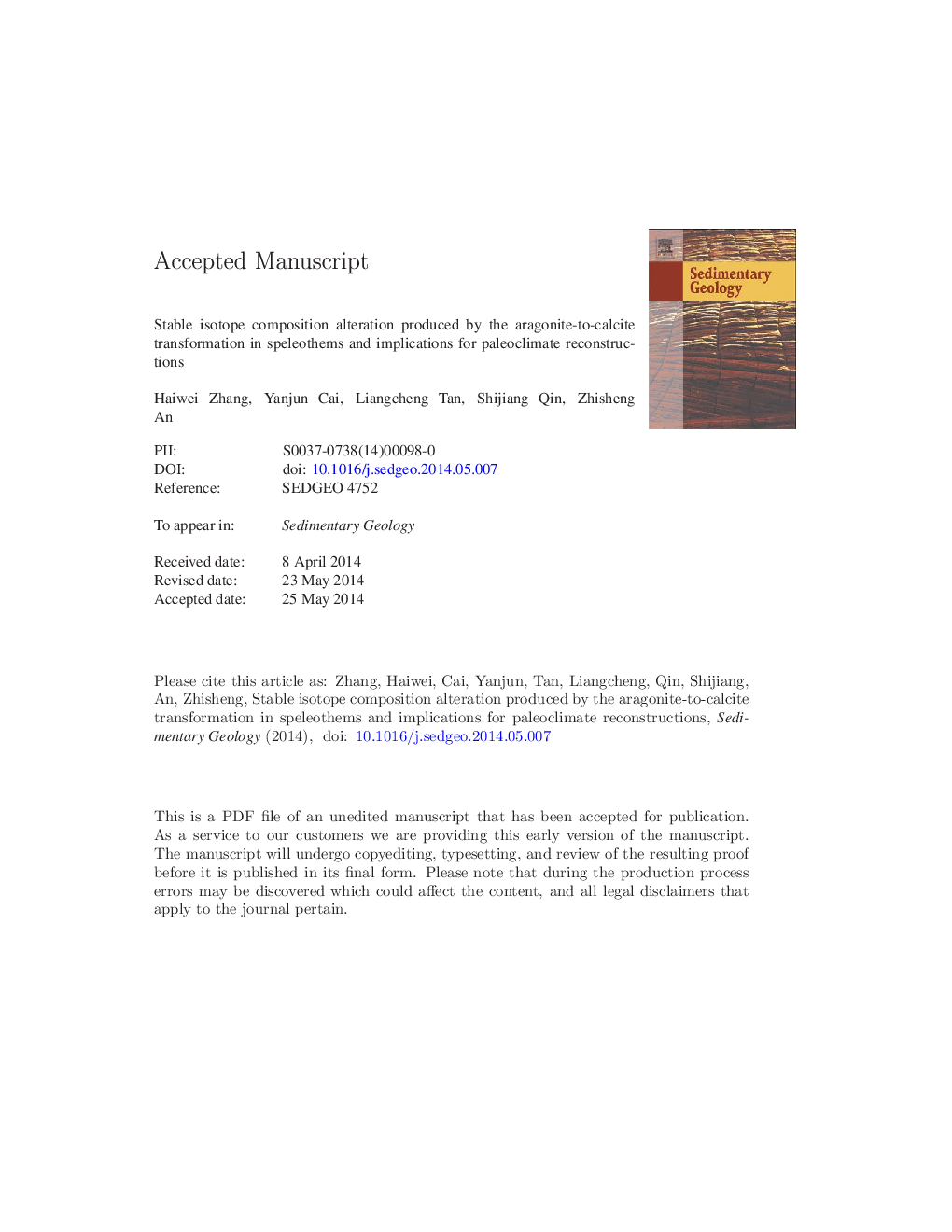| کد مقاله | کد نشریه | سال انتشار | مقاله انگلیسی | نسخه تمام متن |
|---|---|---|---|---|
| 4689391 | 1636054 | 2014 | 54 صفحه PDF | دانلود رایگان |
عنوان انگلیسی مقاله ISI
Stable isotope composition alteration produced by the aragonite-to-calcite transformation in speleothems and implications for paleoclimate reconstructions
ترجمه فارسی عنوان
تغییر ترکیب ترکیبات ایزوتوپ پایدار بوسیله تبدیل آراگونیت به کالسیت در اسپیلتهم ها و پیامدهای آن برای بازسازی های پائولکللیمات
دانلود مقاله + سفارش ترجمه
دانلود مقاله ISI انگلیسی
رایگان برای ایرانیان
کلمات کلیدی
موضوعات مرتبط
مهندسی و علوم پایه
علوم زمین و سیارات
فرآیندهای سطح زمین
چکیده انگلیسی
Aragonite, a mineralogical constituent of speleothems in cave environments, is unstable and susceptible to inversion to calcite, a diagenetic process that involves changes in the mineralogy, texture and geochemistry of speleothems. However, the exact alterations of stable isotope compositions during such diagenesis have not been fully investigated. In this study, two aragonite stalagmites (SN3 and SN15) from the Shennong Cave, southeast China, were found partially inverted to calcite, as determined by X-ray diffraction (XRD) and scanning electron microscopy (SEM) analyses, and thin-section inspections under microscope. The fiber relics and textural ghosts of aragonite preserved in coarse and equant mosaic calcite crystals clearly indicate that the calcite in these two stalagmites were inverted from aragonite. The stable isotope compositions (δ13C and δ18O, given in per mil versus VPDB standard) of primary aragonite and secondary calcite were analyzed and compared, along both growth layers and growth axes. The results show that, along growth layers, differences of δ13C values between aragonite and calcite are negligible (0.1â°-0.2â°), whereas differences of δ18O values between aragonite and calcite are significant (0.63â°-0.87â°). Comparisons along growth axes show similar results: i.e., differences of δ13C values are negligible (0.06â°Â ± 0.22â°) whereas differences of δ18O values are significant (0.85â°Â ± 0.29â°). Most likely, the aragonite in SN3 and SN15 were internally inverted by interactions of trace calcite crystallites and pore water within intercrystalline pore spaces, by a dissolution-reprecipitation process occurring in trapped pore water. In the case of the inversion of aragonite to calcite in speleothems, such as that observed in SN3 and SN15, the δ13C values could be used in paleoclimate and paleoenvironment reconstructions because they are inherited from those of primary aragonite. Although the δ18O values might be cross-calibrated to those of primary aragonite if the aragonite-calcite fractionation offset is known (e.g., 0.85â°Â ± 0.29â° in this study), however, the δ18O values of secondary calcite should be used with caution in such reconstructions as the δ18O offset value is not consistently invariable.
ناشر
Database: Elsevier - ScienceDirect (ساینس دایرکت)
Journal: Sedimentary Geology - Volume 309, 15 July 2014, Pages 1-14
Journal: Sedimentary Geology - Volume 309, 15 July 2014, Pages 1-14
نویسندگان
Haiwei Zhang, Yanjun Cai, Liangcheng Tan, Shijiang Qin, Zhisheng An,
